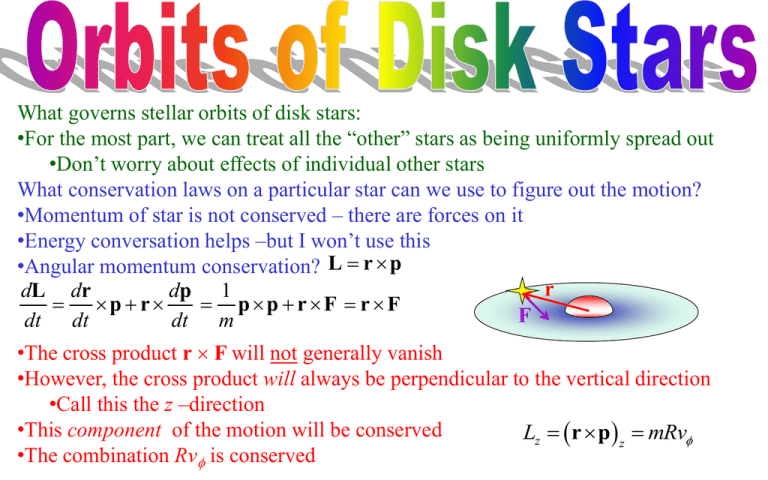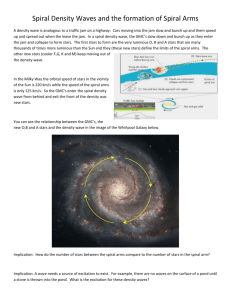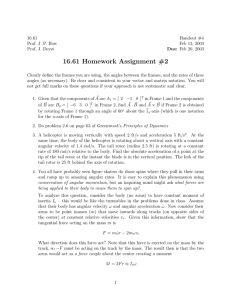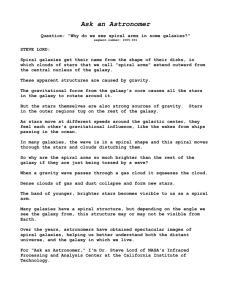What governs stellar orbits of disk stars:
advertisement

What governs stellar orbits of disk stars: •For the most part, we can treat all the “other” stars as being uniformly spread out •Don’t worry about effects of individual other stars What conservation laws on a particular star can we use to figure out the motion? •Momentum of star is not conserved – there are forces on it •Energy conversation helps –but I won’t use this •Angular momentum conservation? L r p r dL dr dp 1 p r pp rF r F F dt dt dt m •The cross product r F will not generally vanish •However, the cross product will always be perpendicular to the vertical direction •Call this the z –direction •This component of the motion will be conserved Lz r p z mRv •The combination Rv is conserved Three types of motion Rv constant •We will be using cylindrical coordinates: •R – the distance from the z-axis, vr the corresponding velocity •z – the vertical distance from the plane, vz the corresponding velocity R • – the angle around, v the corresponding velocity z •There will potentially be three kinds of motion •These will have associated with them three angular frequencies • – angular rate at which it wanders in and out • – angular rate at which it bobs up and down • – angular rate at which it goes around Angular motion – the easiest to understand •The star goes approximately in a circle V 2 R known •Assume we know the angular velocity for circular orbits: •Assume that at some radius R0 this is exactly v v R0 V R0 V0 •Approximate angular velocity and angular period is: V0 2 •At all other radii, we must have: R0V0 T v R0 Rv R0V0 R Up and down motion In the vertical direction, there will be small motions •The star should only be moving a small amount, z small •Locally, the disk looks much like a uniform slab •We found the gravitational acceleration previously 2 d z g z 4 G0 zzˆ 4 G 0 z 2 dt •This looks like Hooke’s Law •Simple harmonic motion d 2z 2 z 4 G 0 2 dt z t z0 sin t •Star bounces up and down Tz 2 In and out motion – Epicycles (1) R0V0 v R In the radial direction, star moves in and out somewhat •I will work in a frame that is rotating around with the galaxy mv2 Fc •In this frame, there will apparently be a centrifugal force R •If it were in a perfectly circular orbit, force would cancel gravitational force, so •Effective force is the sum of these two mV 2 R Fg mv2 mV 2 R d 2R R m 2 Fr Fc Fg dt R R •This will equal mass times radial acceleration •We are only interested in near circular orbits, so R R0 circular and V(R) V0 •Expand, keep only leading order term 2 2 2 2 2 2 2 2 2 2 2 V R R V V R 0 0 0 d R R0 V0 V0 V0 V R 3 2 3 R R dt R R R R In and out motion – Epicycles (2) 2 V02 R02 R 2 2 2 V V R 0 d R 2 3 dt R R •Taylor expand V2(R) around R0, then substitute: V 2 R V 2 R R d V 2 R 0 0 R0 dR V02 R R0 d 2R 1 d 2 R R0 R R0 V R 2 3 R0 dt R R dr •Keep only leading order 2 2 2 2 V 1 d 2 2 0 2V0 d R 1 d 2 2 V R R R V R R0 0 2 2 R R dR R 0 0 0 dt R0 dR R0 d 2R •This is yet another Harmonic oscillator 2 R R0 2 dt R t R0 R sin t 2 Tr Example: flat rotation curves: T 2V02 2 2 2 2 Tr 2 R0 2 Spiral Arms – What causes them? •Spiral Arms vary between galaxies •Most spiral galaxies have two arms •Some have three or four •Some have “partial” spiral arms •The “winding” nature of them is a bit tricky •Not just simple winding! Simple Winding – the Wrong Theory •In one cycle, spiral arms would end up completely wound up •There have been 20 or so circuits since the beginning •Therefore, it’s not this simple •It cannot be the same stars that inhabit the spiral arm on each cycle •Different stars/ clouds and gas inhabit it in each cycle Density waves – the idea behind it •Suppose a region in a rotating spiral galaxy has higher density “clump” •Due to random fluctuations, nearby galaxies, etc. •It attracts gas from in front, from behind, from inside, from outside •But they rotate at different rates, so the “clump” gets spread out •Which causes still more clumps to form •The pattern angular frequency gp will be a little different than the rotation rate •Because it is spreading in both directions •How widespread the pattern can be depends on how many arms m you need •Can show that pattern only works if gp differs from by at most /m. m gp m The spiral arms – what we’re seeing •The “clumping” works best for objects with nearly perfect circular orbits to start with •Works best for cool gas •Molecular clouds – almost in perfect circular orbits •These regions are where the young stars will form •Young stars (the brightest) mark out the spiral arms •Once stars are born, they typically “fall out” of the spiral arms •The spiral arms are not made of particular stars – they change over time



